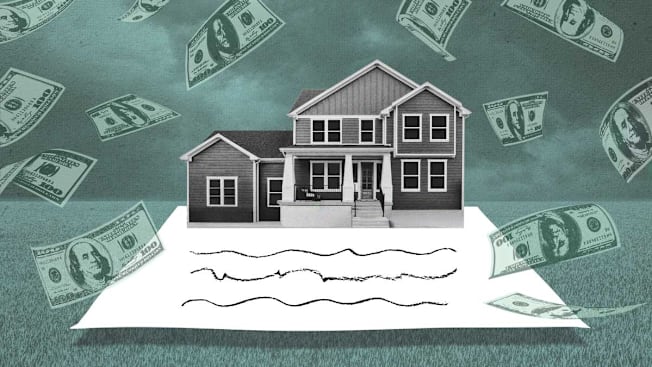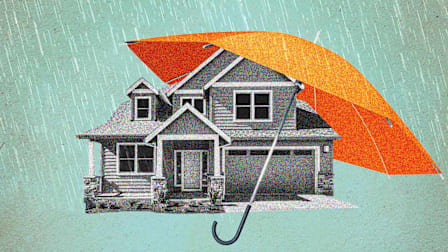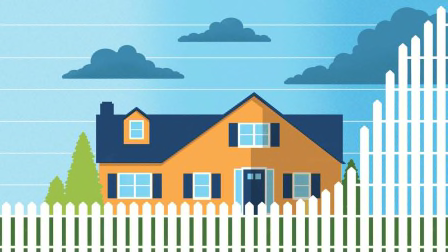Homeowners Are Facing an Insurance Crisis. CR Thinks These 9 Basic Rights Could Help.
Consumer advocates propose a bill of rights. Plus, expert tips on how to protect yourself and your home in the meantime.

Melissa Hudson says she was stunned last year when the insurance premiums on her home in Port Orchard, Wash., shot up 40 percent—even though she’d intentionally bought a home at low risk for fire, floods, and high winds.
Ginger Baldwin in Elgin, Texas, reports going to renew her policy this year and learning that the more than 40 percent premium increase she’d have to pay was related to her “insurance score,” which she didn’t know she had and hadn’t heard of before.
Victoria Knapp of Altadena, Calif., says that after losing her home and its contents in the Eaton fire earlier this year, her insurer insisted she send an itemized inventory of belongings before it would issue any funds.
These experiences are among thousands of consumer stories collected by Consumer Reports in the past 18 months that, together, paint a picture of a full-blown crisis. They include reports of dramatic but unexplained premium increases, policies being dropped with little warning, red tape and unexplained delays in receiving claim payments, and policies that turn out, after disaster strikes, not to provide the protection the homeowners expected.
Right No. 1: A Clear, Plain-Language Explanation of What Is—and Is Not—Covered by Your Policy
A typical homeowners policy covers fire and smoke damage, lightning strikes, hail, and windstorms. But flood and earthquake coverage is usually sold separately, while many other expensive household problems—including outbreaks of mold and worn-out HVAC systems or appliances—are rarely covered at all. What’s more, some policies may only cover the actual cash value, which factors in depreciation, vs. replacement cost value, which uses current prices to calculate how much building anew will cost.
All too often, homeowners don’t know exactly what they’re protected against until it’s too late: According to CR’s 2024-25 survey, 16 percent of homeowners have learned after they filed a claim that they didn’t have enough coverage.
Part of the problem, Enright says, is that consumers don’t get to see their full policy documentation until after it’s purchased—and even then, the “declarations” page that summarizes coverage limits, deductibles, and premium details often doesn’t mention the perils that are not covered.
What CR experts want: Insurers should automatically provide consumers with both the full policy documentation and a standardized, easy-to-read, plain-language summary of coverage before purchase or renewal. And the summary should detail common risks and coverage areas that are not covered so that consumers can make more informed decisions.
How to protect yourself in the meantime: Review your policy with your broker or insurance company agent every year or each time you renew. (CR’s survey found that about 2 in 5 policyholders hadn’t reviewed their coverage in more than a year.) Ask to see the full policy documents in advance, as well as the declarations or summary page. Then ask what’s not going to be covered that a more expensive policy would cover. For more details on what your policy should include, check CR’s homeowners insurance buying guide.
Right No. 2: To Know Which Risk Factors Are Used to Determine Eligibility and Set Rates
It makes sense that a home’s exposure to damage from flooding, hurricanes, tornadoes, or wildfires would figure into the cost of insurance. But consumers often have little to no knowledge about how such risks are measured and factor into premium rates. Many insurers use so-called risk scores, which are often generated by third-party companies and not made available to a consumer.
Last year, for example, Janine Weick’s insurer canceled the policy on her Redmond, Oregon, home and left her scrambling to find coverage. The explanation provided: the high risk of wildfires in the area. Weick says the company didn’t provide a specific wildfire risk score, however, or suggest ways she could “harden” her home against the risk, such as clearing vegetation around her home or retrofitting it with fire-resistant materials.
"Consumers deserve a complete explanation about how various risk factors affect their premium prices, and recommendations for how to reduce those risks and lower their costs where possible. How can homeowners take action to reduce their risk if they don’t have access to this information?" says Enright, noting that, in summer 2025, Montana enacted a law requiring disclosures of wildfire risk scores.
What CR experts want: All insurers should provide consumers a summary of the variables and risks used to determine premiums. Insurers should also inform all applicants of any images or third-party risk scores used in their risk evaluation and, when possible, offer practical steps homeowners can take to reduce their risk and premiums.
How to protect yourself in the meantime: Ask your broker or insurance company agent if any risk scores were used to determine your premium price. These can include, for example, the Federal Emergency Management Agency National Risk Index for hurricanes, wildfires, tornadoes, and other risks; FEMA’s Flood Zone designations; and First Street flood or fire factor scores. Ask what you can do to improve your home’s risk scores and thereby lower your price.
Right No. 3: Fair Access to Coverage Based on Property Risk, Not Your Finances
Ginger Baldwin had several reasons to be surprised when her insurance agent attributed the more-than-40-percent bump in her insurance premium to her “insurance score,” which she says was tied to her credit score.
For one: She’d never heard of an insurance score. Two: She couldn’t think of any reason her credit score might have taken a hit recently. And three: Even if it had, she didn’t understand what it had to do with the cost of insuring her home. “I thought my premiums were based on whether or not I’d ever made a claim,” says Baldwin, 67, who is semiretired and works part-time at an art gallery to make ends meet.
The truth is that credit scores are now routinely used in most states by insurance companies to set individual insurance premiums—on the grounds that they indicate the likelihood that a homeowner will file a future claim. Specifically, companies calculate what’s known as an insurance score, using information from your credit report, a number between 300 and 850 that is calculated based on factors such as how much credit you have available and your payment history.
An August 2025 report by the CFA found that homeowners with a credit score below 600 (out of 850) pay an average of twice as much for home insurance—nearly $2,000 more each year—as neighbors with scores above 750.
“Insurance companies use credit history as a ratings factor to assess the risk that homeowners will experience a loss and file a claim,” says Chuck Bell, financial policy advocate at Consumer Reports. “However, this practice is unfair because it sharply raises rates for financially stressed households who are living paycheck to paycheck, even if they take good care of their home and have never submitted a claim.”
Credit scores are a flawed measure of insurance risk, Bell says, because they can be affected by many factors beyond a person’s control, including job loss, weather disasters, and medical bills. He adds that “credit reports are often riddled with errors that can be very hard to correct.”
CR advocates say using credit scores to set premium rates also increases the number of uninsured households, and places a disproportionate burden on low-income households and economically disadvantaged communities of color.
Still, the insurance industry stands by its use of credit scores. “Over the past 30 years, insurers’ use of credit-based insurance scores has been subject to intense scrutiny and analysis by state insurance regulators and legislators, including the Federal Trade Commission,” Collins at the APCIA says. “Multiple studies have all shown that an individual’s credit history is a proven, accurate indicator of how likely a person is to file a future claim and the potential cost of that claim.”
What CR experts want: Neither credit scores nor other indicators of a homeowner’s financial status should factor into their insurance rates. Insurers in California, Maryland, and Massachusetts are already prohibited from using credit scores this way, and as of this year insurers in New York are barred from denying or canceling coverage due to a property’s affordable housing status or the income level of its residents.
How to protect yourself in the meantime: Ask your broker or insurance company agent if your credit or insurance score was used to determine your rate, and whether there are steps you can take to improve the scores and lower your price. Check your credit report from each of the three main credit bureaus, Equifax, Experian, and TransUnion free of charge at AnnualCreditReport.com. If you find a mistake, file a dispute. Learn more in this guide to improving your credit score.
Right No. 4: To Receive Written Notice and a Full Explanation Well in Advance of Major Changes to Your Insurance Policy
When Melissa Hudson learned that the insurance premiums on her Port Orchard, Wash., home would increase 40 percent from the previous year, she was given no explanation. “We’d only lived here three years and had no claims,” she says. Even after asking, she says, the answer was vague and the only remedy offered was to raise her deductible to get the premium down. Hudson shopped around and found another carrier, but the process was time-consuming. “I deserve to know why such a huge rate increase is necessary and justified,” she says.
Last year, William Wilkin of Nashville, Tenn. received a letter from his insurer saying his homeowners policy would not be renewed going forward. No further explanation was provided. When he contacted his broker, it turned out that satellite photos had been used to determine that his roof was in poor condition. That didn’t sound right to Wilkin, who hired a professional to inspect and photograph the roof, which turned out to be in fine shape. After sending the photos to the insurer, Wilkin was able to renew the policy, but with a 15 percent increase.
“Right now, you don’t have the right to any drone or satellite images or information,” says Bach at United Policyholders, which has proposed legislation in some states that would require insurers to provide all documentation used to determine a nonrenewal.
What CR experts want: A national standard that would require insurers to notify consumers at least 60 days before a policy expires or is canceled, if the premium goes up more than 10 percent, or if coverage is reduced. (Most states currently require notification 30 days or less before a nonrenewal or cancellation.)
As important, consumers should always be given a full explanation for the change, including any written reports or satellite or drone imagery used to make the determination. “You should have the right to review and verify all the information about you or your property that a company uses when making decisions about covering your home, and to have sufficient time to respond, contest errors, or seek out another policy,” Enright says.
How to protect yourself in the meantime: If you face a nonrenewal or other major change to your policy, ask your independent insurance broker or insurance company agent for a detailed, written explanation, including any imagery or reports the insurer used to make the decision. Though you don’t currently have a legal right to this information, insurers are likely to provide it if asked. If you aren’t given a reasonable amount of time to determine why you’re facing a nonrenewal or a large increase, or to find alternative coverage, ask for an extension. Again, the insurer doesn’t currently have to grant you more time, but some will do so as a courtesy.
Right No. 5: To Benefit From Incentives to Harden Your Home Against Severe Weather or Wildfire Risks
Retrofitting your home with fire-resistant roofing and siding or storm doors and windows, and clearing flammable vegetation from around your property, are the kinds of “hardening” measures that can reduce the risk of damage from extreme weather events. A 2020 study by the National Association of Insurance Commissioners (PDF) found that “structural modifications can reduce wildfire risk up to 40 percent, and structural and vegetation modifications combined can reduce wildfire risk up to 75 percent.”
Some insurance companies are willing to lower premiums for homeowners who implement these measures. But in too many cases, advocates say, insurance companies are using hardening measures as a stick rather than a carrot: In CR’s survey, 8 percent of current policyholders said their insurers threatened increased premiums or dropped coverage if they didn’t make certain renovations or improvements.
In addition, it’s often unclear to what extent hardening measures actually help the policyholders maintain or lower the cost of coverage. After a major hailstorm damaged his Colorado Springs, Colo., home in 2023, for example, Eddie Mack says he spent an extra $1,500 retrofitting it with Class 4 hail-resistant shingles. For the effort and expense, Mack was told he would get a 10 percent discount on his policy renewal a few months later. But when the policy was renewed, the discount was less than half what he says he’d been quoted.
Sharon Maxwell had a similar experience. She expected a sizable discount after she spent several thousand dollars hardening her Soquel, Calif., home against fires as part of the state-sponsored Firewise program in 2022. In fact, she says, she got a mere $85 credit, a tiny discount on her then $5,500 premium.
Likewise, George Butts says he sent his insurance company evidence that the local fire marshal had inspected his fire-hardening efforts on his Hesperia, Calif., home. He did not get a discount that year—and his premium shot up 30 percent, he says.
What CR experts want: Insurers should reward consumers with meaningful discounts for hardening their home against weather and fire risks. And it should be made clear exactly how much of a discount a person will receive for various measures, so they can make informed decisions. “Done well, this practice would greatly benefit both insurer and homeowner alike,” Enright says.
How to protect yourself in the meantime: Before starting any hardening projects, ask your insurance company to confirm in writing that doing so will qualify you for a discount. And when it comes time to renew, remind your broker or insurance company agent about the upgrades and provide photos and other documentation to prove they were made.
Right No. 6: Insurance Security During and After Declared States of Emergency
Shortly after Laura Morris’ house in Greenville, S.C., survived Hurricane Helene with minimal damage, her insurer sent a letter saying her homeowners insurance policy would be canceled in 90 days. Outraged, Morris posted on social media, contacted a local TV news station, and spoke with CR to publicize the situation. Her insurer eventually reversed course, though by then she’d found another carrier.
No one should have to resort to such measures, says CR’s Enright. Instead, families should have the security of knowing that if they are struck by a disaster, their policies will be renewed.
What CR experts want: Insurers should offer all policyholders protections like those recently enacted in California, which shield affected policyholders from cancellations and nonrenewals for one year after a declared state of emergency—and for two years if they’ve lost their homes entirely. The rules also require insurers to give policyholders who lose their homes a grace period of at least 60 days for any premium payments that are due.
How to protect yourself in the meantime: After a disaster, ask your insurance company agent or broker for a one- or two-month pause on your premium payments so you can focus on stabilizing your living situation and repairing your home. If your mortgage is backed by the federal government, as with Federal Housing Association (FHA), Department of Veterans Affairs, Fannie Mae, and Freddie Mac loans, you may be entitled to pause those payments as well (this is known as forbearance). Ask your lender if your mortgage qualifies. But even if it doesn’t, lenders may be willing to grant a payment pause as a courtesy after a disaster.
Right No. 7: Face No Penalties for Inquiries or Unpaid Claims
It is widely understood that insurers often raise premiums after policyholders make a claim. But several consumers told CR their premiums were increased after they merely inquired about a potential claim but never submitted it.
This is unfair, say consumer advocates, because it penalizes policyholders for merely seeking the information they need to weigh the pros and cons of making a claim, such as whether damage will be covered and for how much.
Claim inquiries are sometimes added to an industry database known as C.L.U.E. (short for Comprehensive Loss Underwriting Exchange) in the form of "zero dollar" claims, which can happen when a customer call results in a claim number being generated, but the claim is not pursued or no payment is made. Andrew Denton, an independent insurance agent in the Chicago area, says he has seen this happen. Once added, he says, these records can be viewed by other insurers and may influence premiums or eligibility for years, even when no claim was filed. (LexisNexis, which owns the C.L.U.E. database, told CR that claims information “should not be reported when an insurer’s customer merely asks a question about their coverage or deductible” and recommends that consumers review their C.L.U.E. reports and “notify us of inaccuracies.”)
In addition, many insurance providers hike rates following a claim even when they deny the claim and no payout is made. (LexisNexis does advise insurers to report denied claims.) This is especially notable, given that nearly half of homeowner claims at several large insurers end without payment, according to data collected by Weiss Ratings, an independent insurance rating agency. It also emphasizes how important it is for policyholders to be able to make inquiries about their coverage without fear of premium hikes. “Consumers are submitting claims without full understanding of their coverage, and then being punished for it,” Enright says.
What CR experts want: Policyholders should not be penalized with higher premiums or cancellations for simply inquiring with their broker or insurer about a possible claim, or for submitting a claim that results in no payout. And insurers should not report claim inquiries to the C.L.U.E. system unless they result in a paid claim. “You shouldn’t risk premium increases or cancellations just for seeking information from your insurance provider,” Enright says.
How to protect yourself in the meantime: This is one way in which it pays to work with an independent insurance broker—one who’s unaffiliated with particular insurance companies and therefore able to help you choose the best policy for you from among a wide range of providers. Such brokers are under no obligation to report inquiries to C.L.U.E. or similar databases and can advise you on the pros and cons of making a claim.
On the other hand, be cautious about phoning your insurance company directly to discuss a potential claim. If you do, be clear that you’re looking only for information, do not wish to generate a claim number, and don’t want the inquiry reported to the C.L.U.E. database.
Right No. 8: Prompt, Full, and Fair Payment on a Claim
In the aftermath of a disaster, homeowners need insurance payouts quickly—not only to start the rebuilding process, but also for food, temporary housing, and immediate survival needs. But the National Association of Insurance Commissioners says claim processing delays are the most common type of complaint it receives. And 1 in 4 CR survey respondents who had made a claim in the previous five years said it took more than 30 days to receive payment. Six percent of policyholders said it took more than 90 days.
Currently, 16 states have no laws requiring that claims be paid within a set period of time. And of the 34 remaining states, some have lengthier timelines. Florida and New Jersey allow up to 90 days for companies to settle a claim; Michigan and Montana allow up to 60 days. In New York, claims must be paid five days after the claim is accepted.
What CR experts want: Insurers should have to investigate the claim and either pay the homeowner or explain the denial within 30 days. If that’s not possible, the insurer should notify the homeowner, explain the delay, and commit to a reasonable schedule in writing. If a claim is denied, the insurer should provide a detailed explanation for why the claim was not accepted, and offer the policyholder an opportunity and ample time to appeal.
How to protect yourself in the meantime: Keep meticulous records of every interaction with your insurer, and make sure you are home (and taking notes or recording video) when an adjuster visits. If the adjuster advises you to start repairs before your insurance payment comes through, get that permission in writing.
If you are struggling to get your claim paid, consider hiring a public, or independent, adjuster, who will advocate on your behalf with the insurance company. These professionals are usually paid a percentage of the claim amount as their fee. (In some states, the fee is capped at around 12 percent.) Find a public adjuster on the the National Association of Public Insurance Adjusters’ website.
Right No. 9: Immediate and Adequate Financial Support for Emergency Housing and Essentials
In the wake of disaster, homeowners frequently lack access (sometimes permanently) to their property and possessions, including important documents, computers, telephones, electronic records, and banking information. Yet before making payments, insurers often require that policyholders provide “proof of loss,” itemized lists of lost possessions, and detailed estimates of what they’ll need to cover living expenses while they’re displaced. Even then, it can take another month or longer for insurers to review claims and cut checks. In the meantime, survivors often have to borrow (and accrue interest) to cover hotel stays and other vital living expenses.
That’s the situation faced by Victoria Knapp, the current chair of Altadena’s town council, after her family lost its home and everything in it to Southern California’s Eaton fire earlier this year. Three months after the loss, says Knapp, her insurer required her to provide an inventory of her family’s possessions before it would provide any funds.
Other consumers told CR similar stories. One reported that after losing his entire home in a tornado in March 2023, the insurer didn’t pay the claim until July 2024 and, in the meantime, was months behind on living expense payments.
That’s wrong, Enright says: “Insurers should strive to serve their policyholders in their time of need by reducing barriers and providing funds to cover emergency housing needs.”
What CR experts want: All policies should guarantee prompt payment of financial assistance to policyholders after a declared disaster to cover emergency housing expenses, and to offer reasonable leniency in requirements for itemized lists of lost assets. Colorado and Oregon already require that insurers pay 65 to 70 percent of survivors’ personal property coverage for a total loss after a major disaster, without requiring an itemized list of lost assets.
How to protect yourself in the meantime: Create a home inventory of your possessions and store it in the cloud, a safe deposit box, or a fireproof safe. If your area has been declared a state of emergency, or a federally declared disaster, and your home has been damaged, you can apply for FEMA disaster assistance (or call 800-621-3362). Eligibility will depend on the degree of your loss and your financial need, and assistance can include temporary hotel stays, moving and storage expenses, and funds to replace your home or repair damage, including appliances and more.
Editor’s Note: This article, originally published Oct. 21, 2025, has been updated to clarify the circumstances in which claim inquiries may be added to the C.L.U.E. database.




















